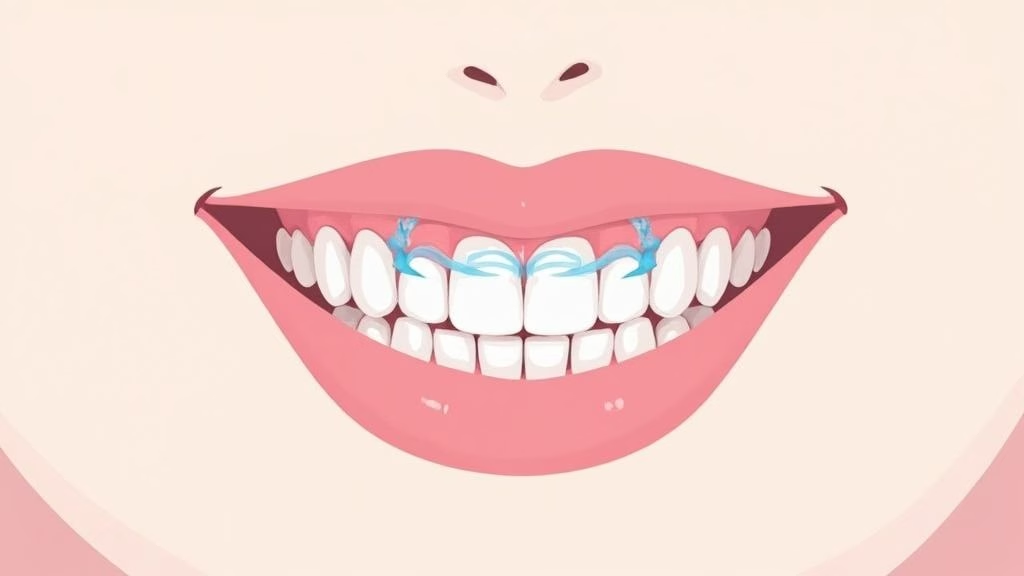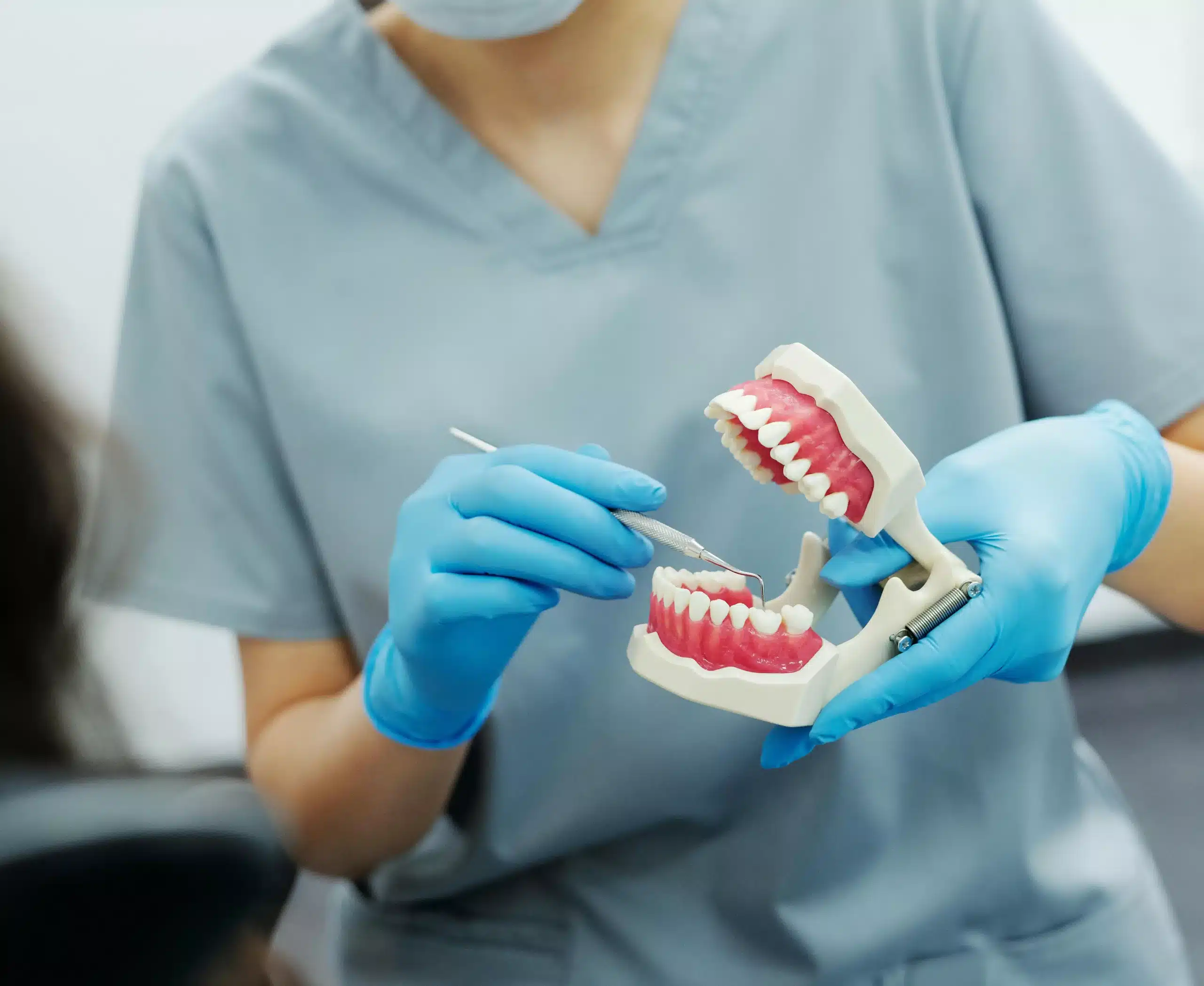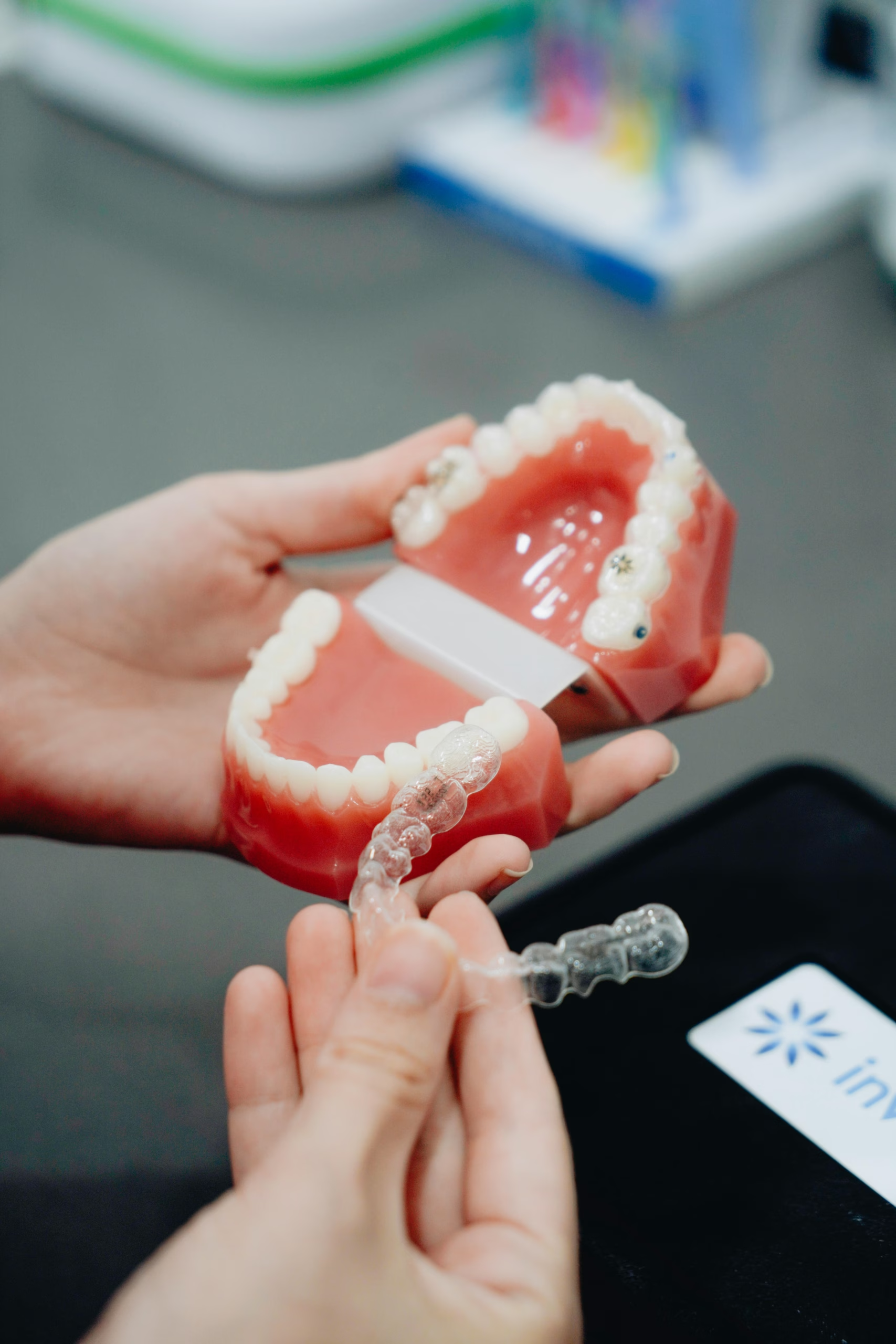How to Strengthen Tooth Enamel a Practical UK Guide
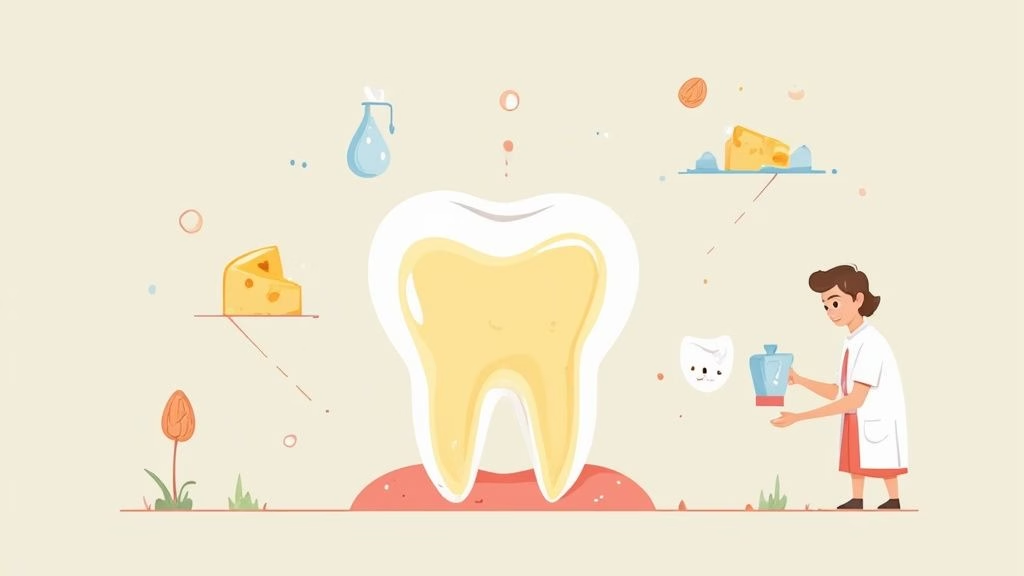
To really strengthen your tooth enamel, the game plan is pretty straightforward: lean into a diet packed with calcium and fluoride, get serious about your oral hygiene by using a fluoride toothpaste, and dial back on the acidic and sugary stuff. This trifecta helps your teeth remineralise, building them back up to be stronger and more resilient against decay.
Understanding Your Smile’s First Defence
It helps to think of tooth enamel as your smile’s personal bodyguard. It’s the tough-as-nails, protective outer layer of your teeth, shielding the more sensitive inner parts from the daily onslaught of food and drink. In fact, it’s the hardest substance in the human body, built for a lifetime of work.
But it’s not indestructible. The acids in many common foods and drinks can slowly strip away its vital minerals. This process is called demineralisation, and it’s the first step towards bigger problems like sensitivity, yellowing teeth, and eventually, cavities. To get the full picture, it’s worth understanding the broader health impacts of oral care beyond just a nice smile.
The good news? Your body is constantly fighting back through a natural repair process called remineralisation. Minerals like calcium and fluoride, which you get from your diet and toothpaste, get to work rebuilding and strengthening your enamel. Keeping your teeth healthy is all about managing this constant tug-of-war between damage and repair.
The Enamel Protection Cycle
This cycle of demineralisation and remineralisation is happening every single day. Acidic foods and drinks tip the scales towards damage, while good hygiene and a healthy diet push things back towards repair.
This infographic gives a great visual of how this continuous cycle works.
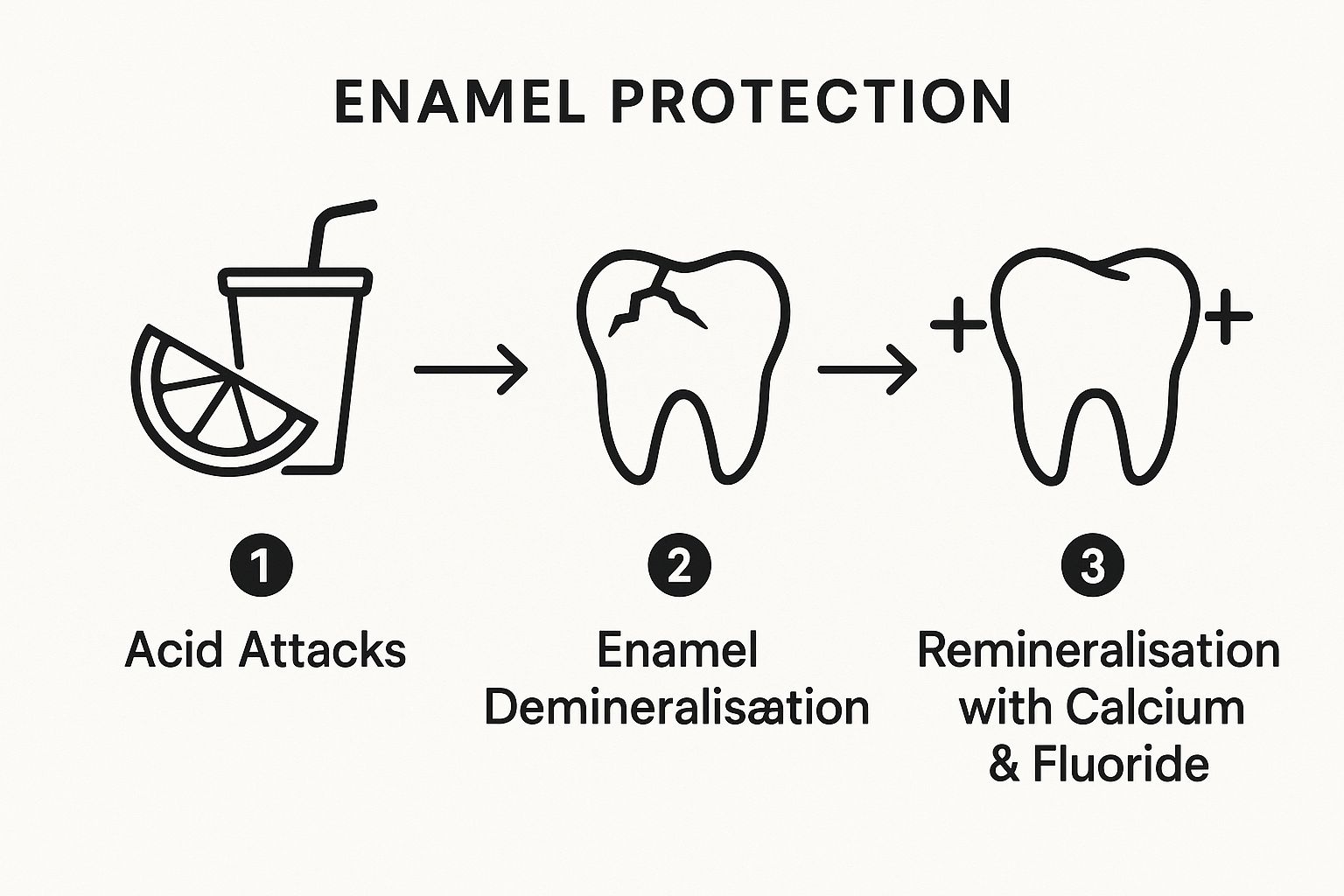
It really brings home how much your daily choices matter. You have direct control over whether your enamel is breaking down or building itself back up. Proactive care is key to keeping the balance firmly on the side of remineralisation.
Why Enamel Health Matters in the UK
Taking an active role in protecting your enamel is particularly crucial when you look at the dental health landscape across the UK. While things have generally improved over the years, tooth decay is still a major concern.
A 2023 survey, for instance, revealed that the prevalence of tooth decay in Year 6 children ranged from 12.1% in the South West to a startling 23.3% in Yorkshire and The Humber. These statistics don’t just show a problem; they highlight deep-seated regional inequalities and underscore a real need for better oral health education. You can dig into the detailed findings of this research on the official government website.
Your smile is an investment, and protecting its foundation—the enamel—is the smartest move you can make. It’s far more effective and affordable to prevent damage than to repair it later.
Seeing this as a constant battle is the first step. The goal isn’t a one-time fix but rather to make consistent, positive choices for your oral health, day in and day out. Even if you’re thinking about cosmetic treatments or getting your teeth straightened, you absolutely need a strong enamel foundation for the best results. While modern dental platforms like Toothfairy offer a smarter, more affordable way to access professional advice and treatment, true, long-lasting dental health really begins with the small things you do every day.
Building Your Daily Enamel Defence Routine
When it comes to learning how to strengthen tooth enamel, small, consistent habits are your most powerful allies. It’s not just about whether you brush your teeth, but how and when you do it. Nailing the details of your daily routine can make a world of difference to the long-term health and resilience of your smile.
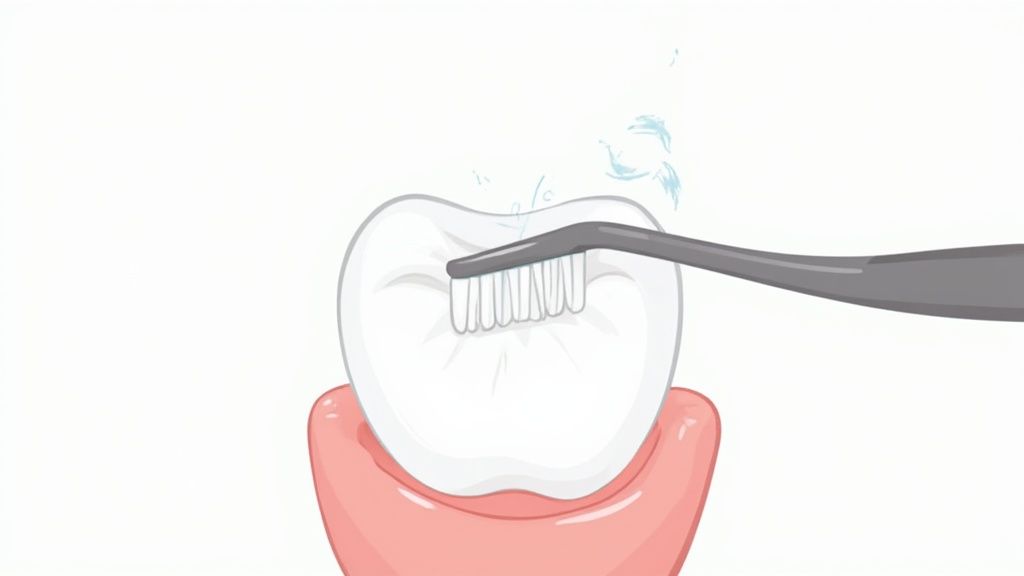
The cornerstone of any solid enamel defence plan is your toothbrush. So many people think that aggressive, hard brushing means a better clean, but this couldn’t be further from the truth. Over time, that forceful scrubbing can actually wear down your precious enamel.
Your best bet? Always choose a soft-bristled brush.
Use gentle, circular motions across the surfaces of your teeth. This technique is brilliant at removing plaque without being abrasive. Think of it less like scouring a pan and more like polishing a treasured piece of furniture.
Timing Is Everything After Meals
Here’s a common mistake I see all the time: brushing immediately after an acidic meal or drink. Think orange juice with breakfast or a fizzy drink with lunch. At that moment, your enamel is temporarily softened by the acid, and brushing right away can cause serious mechanical damage.
Wait at least 30 to 60 minutes after consuming anything acidic before you reach for your toothbrush. This window gives your saliva the time it needs to neutralise the acids and start the natural remineralisation process, re-hardening your enamel.
While you’re waiting, a simple rinse with plain water can help wash away some of that lingering acid. It’s a small habit that goes a long way in protecting your enamel when it’s most vulnerable.
Your Daily Enamel-Strengthening Toolkit
Beyond your brushing technique and timing, the products you choose and the habits you stick with are absolutely non-negotiable for building stronger enamel. These are the essentials for an effective routine.
- Fluoride Toothpaste is Your Hero: Fluoride is the star player in enamel health. It actively integrates into your tooth structure, forming a new, tougher surface that’s far more resistant to acid attacks. Using a fluoride toothpaste twice a day is the single most important thing you can do for active remineralisation.
- Don’t Skip the Floss: Your toothbrush can’t reach everywhere. Plaque and food particles love to hide between your teeth, creating perfect breeding grounds for acid-producing bacteria. This is where enamel erosion and cavities often start. Daily flossing is absolutely crucial for protecting these vulnerable spots.
Making tiny adjustments to your daily life can have a huge impact. It’s often easier than you think to swap a harmful habit for one that protects your smile.
Simple Daily Swaps for Healthier Enamel
| Common Habit | Enamel-Friendly Swap | Why It Helps |
|---|---|---|
| Brushing immediately after breakfast | Brush before breakfast, then rinse with water | This removes plaque first, preventing bacteria from feasting on your food and producing acid. |
| Snacking on sugary sweets all afternoon | Eat sweets as part of a main meal | This limits the duration of the acid attack on your teeth to a single, shorter period. |
| Sipping on fizzy drinks or juice | Drink it all in one go, preferably with a straw | A straw bypasses your front teeth, and finishing the drink quickly reduces the time your enamel is exposed to acid and sugar. |
| Using a hard-bristle toothbrush | Switch to a soft-bristled brush | A soft brush cleans just as effectively without scrubbing away and damaging your enamel over time. |
These small changes might seem minor, but when practised consistently, they create a powerful defensive shield for your teeth day in and day out.
Sadly, many people struggle to establish even these fundamental habits, a problem often made worse by difficulties in accessing professional dental care. In the UK, a quarter of people admit to brushing only once a day. What’s more, over 43% of children haven’t seen an NHS dentist in the past year, resulting in as many as 70 children a day needing teeth extracted due to decay. The Great British Oral Health Report highlights the scale of the issue.
This reality makes your daily routine more critical than ever. When professional check-ups are hard to come by, your at-home care becomes the primary line of defence. Whether you’re maintaining your smile or considering a smarter, more affordable teeth-straightening solution like Toothfairy, a rock-solid daily routine is the bedrock of lasting oral health.
Your Enamel-Strengthening Diet Plan
What you eat can be your enamel’s greatest ally or its worst enemy. Beyond just avoiding cavities, your diet is a powerful tool you can use to actively remineralise your teeth, essentially rebuilding and strengthening them from the inside out. Shifting your focus to an enamel-friendly diet is one of the most effective things you can do to protect your smile for years to come.

This isn’t about harsh restrictions; it’s about making smart, deliberate choices. When you load your plate with foods that build enamel and know which ones to limit, you give your teeth the raw materials they need to stay strong and resilient against daily acid attacks.
Foods That Build Strong Enamel
Think of these foods as the construction crew for your smile. They’re packed with the minerals—primarily calcium and phosphorus—that are the literal building blocks of your tooth enamel. Vitamin D is the site foreman, making sure your body can actually absorb and use all that brilliant calcium.
Here are some top enamel-builders to pop on your shopping list:
- Dairy Products: Cheese, milk, and plain yoghurt are absolute powerhouses of calcium and phosphate. Cheese is particularly brilliant because it also helps raise the pH level in your mouth, neutralising acid and getting your saliva flowing.
- Leafy Greens: Spinach, kale, and other dark leafy greens are loaded with calcium and folic acid, which is great for both your teeth and gums.
- Lean Proteins: Things like chicken, fish, and eggs are rich in phosphorus, the mineral that works hand-in-hand with calcium to fortify your enamel.
- Nuts and Seeds: Almonds are a fantastic choice. They’re a great source of both calcium and protein, and they’re naturally low in sugar.
Eating these foods actively helps the remineralisation process, patching up microscopic weak spots in your enamel before they have a chance to turn into bigger problems.
Your mouth’s best natural defence is saliva. It washes away food, neutralises damaging acids, and delivers those essential minerals back to your teeth. A simple but highly effective trick is to chew sugar-free gum after meals to stimulate saliva flow and give this natural process a boost.
Watch Out for Enamel Wreckers
Knowing which foods and drinks actively harm your enamel is just as important as knowing which ones help. It’s not always about the obvious culprits like sweets and fizzy drinks, either. Many seemingly “healthy” options can contain hidden acids and sugars that cause significant damage over time.
Be mindful of these primary offenders:
- Acidic Fruits and Juices: Citrus fruits like lemons and oranges, along with their juices, are highly acidic and can directly erode enamel.
- Sports and Energy Drinks: Often marketed as healthy, these are typically a double-whammy of sugar and acid—a perfect storm for demineralisation.
- Sticky and Starchy Foods: Crisps, crackers, and even white bread can get trapped between your teeth, where bacteria quickly convert their starches into damaging acids.
Limiting these is key. For a more in-depth guide to protecting your teeth through what you eat, check out these practical strategies for cutting back on sugar. Simple habits can also make a huge difference. Try using a straw when drinking acidic beverages and always rinse your mouth with plain water after meals. This reduces the contact time between these wreckers and your teeth, giving your enamel a real fighting chance.
Using Fluoride for Maximum Enamel Protection
When it comes to strengthening tooth enamel, one ingredient stands head and shoulders above the rest: fluoride. This naturally occurring mineral is, without a doubt, your teeth’s best line of defence against the daily acid attacks from food and drink. Its mechanism is beautifully simple yet incredibly effective, which is why it’s the cornerstone of modern preventative dentistry.
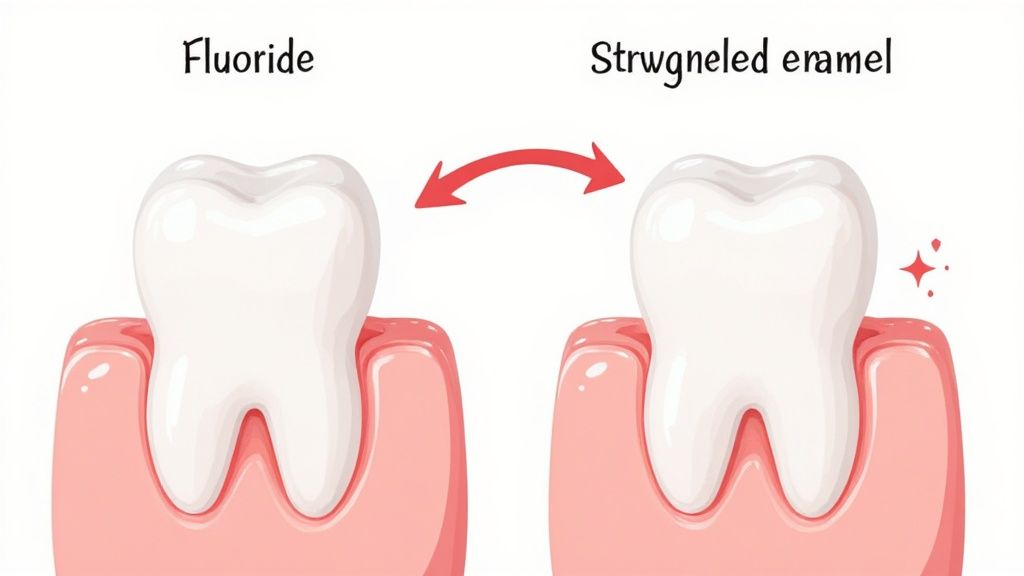
Here’s how it works. When acid weakens your enamel (a process called demineralisation), fluoride gets involved in the natural repair process (remineralisation). But it doesn’t just patch things up. It actively upgrades your enamel’s structure.
Fluoride ions integrate into the enamel’s crystal matrix, forming a new, super-resilient surface known as fluorapatite. This new material is much tougher and significantly more resistant to future acid attacks than your original enamel ever was. It’s a bit like giving your teeth a coat of armour.
Your Best Fluoride Sources
To get the full benefit, you need to ensure your teeth get a consistent supply of fluoride. Luckily, there are a few highly effective ways to work it into your daily routine.
- Fluoride Toothpaste: This is the absolute foundation of good oral hygiene. Brushing twice a day with a toothpaste containing at least 1350-1500 parts per million (ppm) of fluoride is non-negotiable for daily enamel support.
- Fluoride Mouthwash: For an extra layer of protection, consider using a fluoride mouthwash. The key is to use it at a different time to brushing – after lunch is perfect – to top up your fluoride levels during the day.
- Professional Treatments: Your dentist can apply a high-concentration fluoride varnish during a check-up. This treatment delivers a powerful, slow-release dose of fluoride directly where it’s needed most, offering robust protection for several months.
Think of it as building multiple lines of defence. Each method ensures your enamel is constantly being repaired and fortified against the threat of decay.
Here’s a crucial tip that every dentist will give you: after brushing with fluoride toothpaste, just spit, don’t rinse. Swilling with water immediately washes away all that concentrated fluoride, basically undoing all the good work. Let it sit on your teeth and do its job.
The UK Water Fluoridation Gap
While some countries have widespread water fluoridation schemes as a public health measure, this isn’t the reality for most of the UK. This is a shame, as it’s one of the most effective ways to passively strengthen teeth and prevent decay across the population.
Worryingly, only about 1 in 10 people in England has access to optimally fluoridated water. You can actually look up the data on the government’s public health site to see how this varies by region.
What this means for you is simple: you can’t rely on tap water to provide the fluoride your teeth need. The responsibility falls to you to be proactive with your toothpaste, mouthwash, and professional treatments. This is especially important if you’re considering cosmetic work. For instance, before starting a treatment like straightening your teeth with a specific aligner brand, a strong enamel foundation is essential. Services like Toothfairy provide accessible dental check-ups where a professional can help you build the best fluoride strategy for your unique needs, ensuring your teeth are healthy and strong enough for any future treatments.
When It’s Time to See Your Dentist
Your daily routine is your first line of defence, but sometimes, home care just isn’t enough to get your enamel back on track. It’s crucial to know when to wave the white flag and call in a professional. Catching problems early can save you a world of hassle and expense down the road.
A major red flag? Tooth sensitivity that just won’t quit, or worse, is getting more intense. If that sip of hot tea or bite of ice cream sends a jolt through your tooth, it’s a sign your enamel has worn thin, exposing the sensitive dentine layer beneath. Don’t just grin and bear it; that’s your cue to get an expert opinion.
How to Spot Enamel Erosion Yourself
Beyond just sensitivity, your teeth can give you visual clues that something’s amiss. Keep a close eye on any changes, no matter how subtle they might seem at first.
- Yellowing: As your enamel thins, the naturally yellower dentine layer underneath starts to show through. This is why your teeth might look a bit duller or more discoloured than they used to.
- Chips and Cracks: Think of enamel as your teeth’s armour. When it’s weakened, it’s far more likely to get damaged. If you notice tiny, unexplained chips or fine cracks (often called craze lines) along the edges of your teeth, it’s a sure sign of weakness.
- Dents on Your Teeth: You might even spot tiny indentations, or “cups,” on the chewing surfaces of your molars. This is where the enamel has quite literally been worn away by acid or grinding.
If any of these sound familiar, it’s time to move past home remedies and book a dental appointment.
Professional Treatments That Can Help
When enamel erosion has gone too far, your dentist has a whole arsenal of treatments to restore your teeth’s strength and appearance. For smaller issues like minor chips or slight discolouration, dental bonding is a fantastic, straightforward fix. A dentist simply applies and shapes a tooth-coloured resin to cover the damaged area.
For more widespread wear and tear, veneers are a brilliant option. These are super-thin, custom-made porcelain shells that fit perfectly over the front of your teeth. They act as a new, incredibly durable outer layer, giving you a fresh, protected smile. Of course, this is something you’ll need to discuss with a professional to see if it’s the right move for you.
Navigating dental care, especially for restorative or cosmetic work, can feel daunting and pricey. Modern services like Toothfairy are changing the game by offering an easier, more affordable way to get professional advice and treatment. From emergency video chats to cosmetic procedures, it’s all supervised by qualified UK dentists.
Finally, don’t overlook the alignment of your teeth. If your teeth are crowded or crooked, they create all sorts of nooks and crannies where plaque can hide and launch acid attacks on your enamel. Straightening your teeth isn’t just about aesthetics; it makes them so much easier to clean properly. This helps protect and strengthen your enamel simply by preventing plaque from building up in those hard-to-reach spots. It’s a classic case of how improving your smile’s structure pays off massively for its long-term health.
Common Questions About Tooth Enamel
Even with all the right information, a few questions always pop up. It’s completely normal. Let’s walk through some of the most common things people ask about strengthening their enamel, so you can feel confident you’re on the right track.
Can Tooth Enamel Actually Grow Back?
This is a big one, and the answer isn’t a simple yes or no. The crucial thing to understand is that once enamel is physically gone—worn down from grinding or completely dissolved by acid—your body can’t make more. It doesn’t regenerate like skin.
However, and this is where the good news comes in, you can repair weakened enamel through a process called remineralisation. Think of it like patching up tiny potholes in a road before they become major craters. Minerals like calcium and fluoride from your food and toothpaste act like a repair crew, reinforcing the existing enamel structure.
So, while you can’t regrow chunks of lost enamel, you absolutely have the power to strengthen what’s left.
What’s the Difference Between Sensitivity and a Cavity?
It’s easy to confuse the two because, well, they both hurt! The key difference often lies in the type and trigger of the pain.
Tooth sensitivity usually feels like a short, sharp shock of pain. It’s often a reaction to something hot, cold, sweet, or acidic hitting your teeth. This happens when your enamel has thinned, leaving the more sensitive layer underneath (the dentine) exposed.
A cavity, on the other hand, is actual decay that has created a hole in the tooth. The pain is typically more specific to one tooth. It might be a constant, dull ache or a sharp pain when you bite down on food. Sensitivity is a warning sign; a cavity is structural damage that needs a dentist’s help.
Your takeaway here is simple: any persistent tooth pain is your body telling you to book a dental appointment. It’s the only way to know for sure what’s going on and get it sorted properly.
How Long Until I See Real Improvements?
Patience is a virtue when it comes to strengthening enamel. You’re not going to feel a dramatic difference overnight, but with consistent, good habits, you should start to notice less sensitivity within a few weeks to a couple of months.
Remineralisation is a constant, ongoing process. Every single time you brush with a fluoride toothpaste or have a glass of milk, you’re helping your teeth. Just stick with your routine, and know that you’re building a stronger, more resilient smile for the long haul.
Is Teeth Whitening Safe for Weakened Enamel?
A very sensible question. While professional whitening is generally safe, the ingredients can cause temporary sensitivity. This is especially true if your enamel is already a bit thin. This is why it’s absolutely essential to talk to your dentist before reaching for any whitening kit.
Your dentist can take a look at your enamel and tell you what the best and safest approach is. Sometimes, they might recommend focusing on strengthening your enamel first for a few months before you start whitening. This way, you can get the brighter smile you’re after without compromising your tooth health.
Ready to take the next step towards a healthier, more confident smile? Whether you need professional advice on strengthening your enamel, are considering cosmetic treatments, or want a smarter way to straighten your teeth, Toothfairy makes expert dental care accessible and affordable. Discover modern dentistry supervised by qualified UK dentists at https://www.toothfairyapp.co.uk.
Last updated on October 13, 2025

Toothfairy Care Team
Toothfairy, is the world's smartest dental app, that connects patients to a dentist for a range of issues, from emergencies, cosmetics, prescriptions to virtual exams.
Toothfairy Care Team
Toothfairy, is the world's smartest dental app, that connects patients to a dentist for a range of issues, from emergencies, cosmetics, prescriptions to virtual exams.
